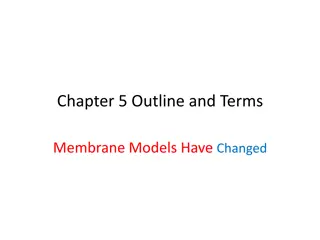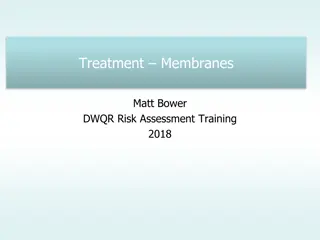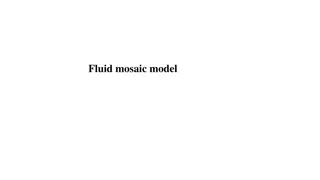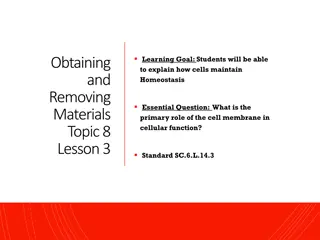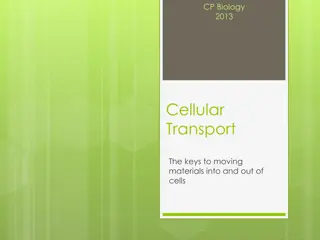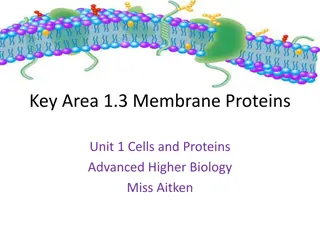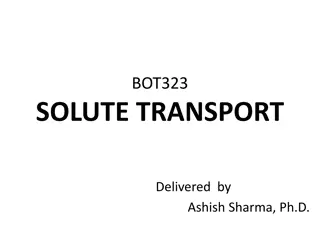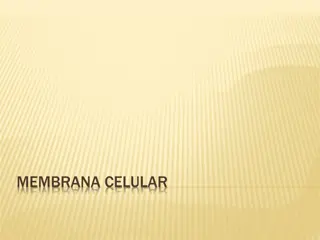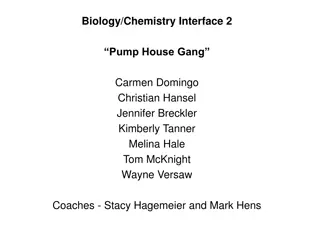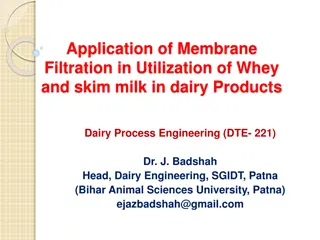Understanding Cell Membrane Structure and Function
This educational content delves into the structure and function of the cell membrane, covering topics such as the fluid mosaic model, permeability, carrier-mediated processes, and membrane proteins. It explains the composition of the cell membrane, selective permeability, and the roles of integral and peripheral membrane proteins. Through detailed images and explanations, readers can grasp the fundamental aspects of cell membrane biology presented in a clear and concise manner.
Download Presentation

Please find below an Image/Link to download the presentation.
The content on the website is provided AS IS for your information and personal use only. It may not be sold, licensed, or shared on other websites without obtaining consent from the author. Download presentation by click this link. If you encounter any issues during the download, it is possible that the publisher has removed the file from their server.
E N D
Presentation Transcript
Cell Membrane and Cell Membrane and Transport Transport Red: very important. Green: only found in males slides. Purple: only found in females slides. Gray: notes. Physiology Team 436 Foundation block lecture 2 Lecture: If work is intended for initial studying. Review: If work is intended for revision. 1
Objectives: Describe fluid mosaic model, membrane structure & function Define permeability & factors influencing it Identify carrier- mediated processes 1) Primary active 2) secondary active 3) facilitated diffusion 2
Structure of the cell membrane (Plasma membrane) Characteristics: It covers the cell Thickness: 7.5-10 nm Selectively permeable It is fluid, not solid Composed of: 55% proteins 42% lipids 3% other (Can be carbohydrates) 1. 1-Phospholipids (most abundant) 25% 2-Cholestrol 13% 3-Other 4% (Can be Glycolipid) 2. 3. 4. 5. Interior of the Phospholipid bi-layer: amphipathic (Hydrophilic head+ hydrophobic tail) Phospholipid: Head: Phosphate / Glycerol Tail: fatty acid 3
REMEMBER Cell membrane is composed of a lipid bilayer Cell membrane = plasma membrane 4
What does Selective Permeability mean? The membrane allows some substances to cross it but not others. A. Through proteins: Water-soluble substances (Glucose, ions) Directly through the bilayer: Fat-soluble substances (O2, CO2, OH) This controls the type & amount of substances entering and leaving the cell. It arises from the membrane structure. B. 5
Membrane Proteins (Two categories) Integral Peripheral Span the thickness of the membrane Function: 1. Channels (or pores) 2. Carrier proteins 3. Receptors Only attach to the surface of the membrane (or attached to integral proteins) Function: Hormone receptors and Enzymes 6
Channel vs. Carrier Proteins Form open pores that allow molecules of the appropriate size (e.g. Ions) to pass the membrane. Similar to a normal door. Channel proteins Selectively bind the small molecule to be transported and then undergo a conformational change to release the molecule on the other side of the membrane. Similar to electronic door. Carrier proteins 7
Carbohydrates of the Cell Membrane *Carbohydrates CHO s* membrane carbohydrates are on the surface bounded to lipids or proteins of the membrane If attached to Proteins Glycoproteins (mostly) Lipids Glycolipids If bound together by proteins Proteoglycans Function: 1. Receptors 2. Attach cells to each other (Cell Adhesion) 3. Immune reaction (They help protect the cell by differentiating host friendly cells from enemy cells) 4. Give most of cells overall negative surface 8 Glycocalyx: a loose coat of carbohydrate molecules outside the cell. Functions as a first layer of defense
The Fluid Mosaic Model of Plasma Membrane 9
Types of Membrane Movement: Passive Transport: Active Transport: Simple diffusion Primary active transport Facilitated diffusion Secondary active transport Osmosis 10
Transport Mechanisms: The transport of material between body or cellular compartments can be divided into: Passive Transport Active Transport Molecules move down or along their energy gradient. Does not require energy. Molecules move against their energy gradient. require energy. 11
Passive Transport (Osmosis) Osmosis : Movement of water from an area of low solute concentration (hypotonic) to an area of high solute concentration (hypertonic) 12
Passive Transport (Diffusion) Diffusion: Random movement of substance either through the membrane directly or in combination with carrier protein down concentration gradient. This gradient can be: Concentration. Electrochemical. Pressure. 13
Passive Transport ( Types of Diffusion) Simple diffusion The movement of molecules through the intermolecular spaces or membrane openings (channels) without the necessity of binding to a carrier protein on the membrane. Facilitated diffusion The transported molecule binds to a carrier protein which then undergoes a conformational change allowing the molecule to pass through to the other side of the cell membrane. The carrier facilitates passage of the molecule through the CM. 14
15 Amazing video summarizing cellular transport: https://m.youtube.com/watch?v=UgN76naeA1Q
Substances that can cross the Cell Membrane Cross freelyby diffusion Cross through membrane proteins 16
Substances that can cross the Cell Membrane Cross through membrane proteins Cross freely by diffusion 17
Substances that can cross the Cell Membrane Achieved through a trans-membrane protein: carrier/transporter/channel 18
Passive Transport (Simple Diffusion): 1 1- -Simple Simple Diffusion: Diffusion: 2- through the channel protein Its require transport protein (channel protein). EX: 1- Large and lipid-insoluble substances (charged molecule). 2-Water-soluble substances (water, ions) pass through channels that penetrate through the cell membrane. 1- directly through the lipid bilayer Pass through the interstices of the lipid bilayer EX : small lipid- soluble substances (uncharged substances, O2, CO2, alcohol, steroid and general anesthetic). 19
Passive Transport (Simple Diffusion) Non-carrier: mediated transport down an electrochemical gradient. Diffusion of non-electrolytes: (uncharged) from high concentration to low concentration. Diffusion of electrolytes: (charged) depends on both chemical as will as electrical potential difference. 21
Passive Transport (Simple Diffusion) 2-Number and sizes of opening in the membrane for the substance pores (selective gating system) 1-Amount of substance available. Rate of simple diffusion 3-Chemical concentration difference. Net diffusion= P x A (Co-Ci) 4-Electrical potential difference. EPD= 61 log C1/C2 5-Molecular size of the substance. 6-Lipid solubility 7-Temperature 22
Passive Transport (Facilitated Diffusion) 2- Facilitated diffusion: also called (Carrier mediated diffusion) Diffusion of a substance is facilitated by the use of a specific carrier protein. Diffusion continues until equilibrium is reached or terminated. Examples: Glucose, amino acids. 23
Passive Transport (Facilitated Diffusion) concentration binding of protein. If all proteins are occupied we achieve full saturation. Saturation : Features Of Carrier Mediated Transport: (Facilitated diffusion) The binding site recognizes a specific substance D-glucose but not L-glucose . Stereospecificity : Chemically similar substances can compete for the same binding site D- galactose / D-glucose. Competition : 24
Passive Transport (Facilitated Diffusion) Substance binding site substance protein complex conformational changes release of substance. 25
Passive Transport rate of diffusion (Simple Vs. Facilitated) Simple diffusion Facilitated diffusion The rate of diffusion increases proportionately with the concentration of the diffusing substance until it reaches a maximum Vmax. At Vmax, an increase in the concentration of the diffusing substance does not increase the rate. The rate of diffusion increases proportionately with the concentration of the diffusing substance. 26
* . The rate at which molecules can be transported by facilitated diffusion depends on the rate at which the carrier protein molecule can undergo conformational change back and forth between its bound and unbound state. 27
Factors Affecting Net Rate of Diffusion: Size. Temperature. Steepness of the gradient: 1-Concentration difference. 2-Membrane electrical difference. 3-Pressure difference. Charge. Pressure. 28
Active transport Occurswhenacellmembranemoves moleculesorions up-hill againsta concentrationgradient (or up-hill againstan electricalorpressuregradient). Examples include: Ions like: sodium, potassium, calcium, iron, iodine, hydrogen ions. Amino acids, glucose and other sugars. Requiresenergyandacarrierprotein 29
According to the source of energy used to facilitate transport, it can be divided into; 30
Primary Active Theenergyisderived directlyfrombreakdown of(ATP) to ( ADP) this breakdown will release energy Examplesinclude: Sodium-Potassium ATPasepump CalciumATPasepump. HydrogenATPasepump. 31
Functions: Maintaining Na+ and K+ concentration difference. Establishes ve potential inside the cell. Maintains a normal cell volume. It is the basis of nerve signal transmission. Pump Characteristics: 1- Carrier protein is made of alpha and beta subunits. 2- Na binding site is inside, K binding site is outside. 3- It has ATPase activity In the first body fluid lecture we decided that the intercellular fluid has more K and less Na, also extracellular fluid has more Na and less K. If the cell have more Na inside and more K outside that the cell will burst, therefore, this pump functions by moving 3 molecules of sodium OUT and 2 molecules of potassium INTO the cell both against their concentration gradients to maintain the body fluid balance. 32
More examples: Function: Maintains low Ca+2 concentrations in the cell 1- Ca+2ATPasePump Presentin: A) Sarcoplasmicreticuluminmusclecells B) Mitochondria C) Somecellmembranes. Function: A) Secretes HCL in stomach B) Excretes acids from the body 2- H+ ATPase (OR H+-K) Pump Present in: A) Parietal stomach cells B) Intercalated cells of distal renal tubule Generally: Pumps H out of the cell into lumen H+-K ATPase inhibitors treat ulcer disease (omeprazol) 33
Secondary Active Transport Theenergyisderived Type of secondary active transport indirectly byusingthe concentrationor electrochemicalgradient generatedbyaprimary 1-Counter- Transport 2-Co-Transport activetransporter. More Explanation (Co Transport) : In primary NA-K pump, the concentration of sodium is more outside the cell, therefore the sodium will move into the cell with it s gradient, and goes back outside to maintain body fluid balance. When Na moves inside, the cell will use energy from the concentration gradient using a carrier, but the carrier has place for another molecule (glucose, against its gradient) to pass with Na, sodium can not move alone. 34
Co-Transport Whenbothsubstances aretransported togetherinthesame direction. Examples: 1- Na+-Glucose 2- Na +-amino acid 3- In the Kidney Counter-Transport Whenonesubstanceis transportedinthe oppositedirectiontothe othersubstance. Examples: 1- Na+-H+ (Kidney) 2- Na+-Ca+2 (Many cell membranes) 35
Thank you! . The Physiology 436 Team: Lina Alwakeel Rana Barassain Heba Alnasser Munira Aldofayan Sara Alshamrani Sundus Alhawamda Ruba Ali Rehab Alanazi Norah Alshabib Nouf Alaqeeli Buthaina Almajed Alaa Alaqeel Fahad Al Fayez Ibrahim Al Deeri Hassan Al Shammari Abdullah Al Otaibi Abdullah Al Subhi Ali Al Subaei Omar Al Babteen Foad Fathi Faisal Al Fawaz Muhammad Al Aayed Muhammad Al Mutlaq Nasser Abu Dujeen Waleed Al Asqah Team Leaders: Qaiss Almuhaideb Lulwah Alshiha Contact us: Physiology436@gmail.com @Physiology436 36



